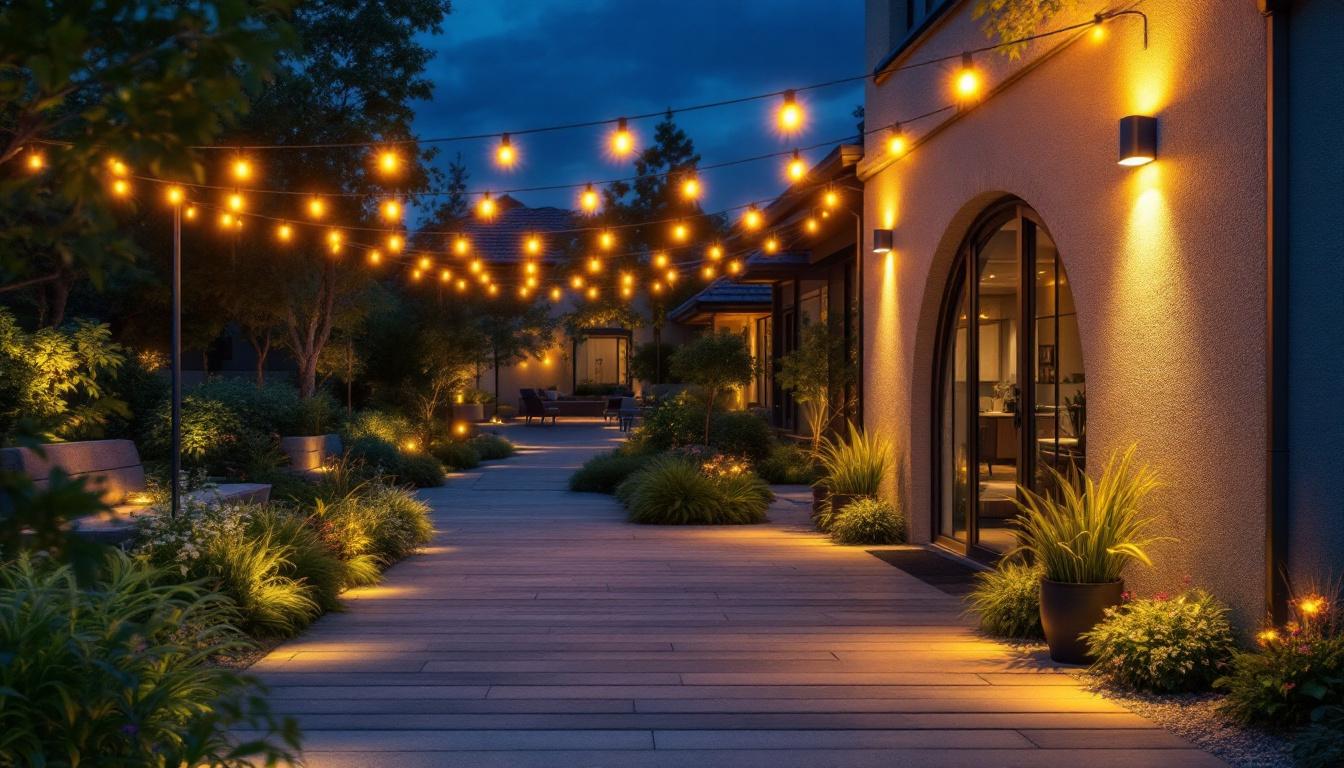
outdoor lighting plays a crucial role in enhancing the aesthetics and functionality of residential and commercial spaces. It not only illuminates pathways and driveways but also highlights architectural features, ensuring safety and security. For lighting contractors, mastering the nuances of outdoor lighting is essential for delivering quality installations that meet client expectations.
post lamps, in particular, serve as elegant fixtures that can transform outdoor environments. These lamps can be strategically placed to provide ambient lighting, accentuate landscaping, or guide visitors along pathways. Understanding how to effectively train a team in the installation and maintenance of these fixtures is vital for any lighting contractor aiming for excellence.
Post lamps are versatile lighting solutions that can be utilized in various outdoor settings, from gardens to parking lots. They come in different styles, materials, and heights, allowing for a wide range of applications. By training your team to understand the specific roles of these lamps, you can ensure that they are installed in a manner that maximizes their effectiveness.
For instance, post lamps can serve as focal points in landscaping, drawing attention to beautiful features like flower beds or sculptures. Additionally, they can provide necessary illumination for safety in areas where visibility is a concern. By educating your team on these applications, they can make informed decisions during installations, ultimately leading to higher client satisfaction.
Moreover, the energy efficiency of modern post lamps has become a significant consideration for both contractors and clients alike. With the advent of LED technology, these fixtures not only consume less power but also have a longer lifespan compared to traditional lighting options. This shift not only reduces the overall energy costs for homeowners and businesses but also aligns with growing environmental concerns. By incorporating energy-efficient options into your offerings, you can position your services as both cost-effective and eco-friendly, appealing to a broader clientele.
Furthermore, the integration of smart technology into outdoor lighting systems has opened new avenues for customization and control. Many post lamps now come equipped with features such as motion sensors, timers, and remote access via smartphone applications. This level of sophistication allows users to tailor their outdoor lighting to their specific needs, enhancing both convenience and security. Training your team to install and configure these smart systems will not only elevate the quality of your installations but also set your services apart in a competitive market.
Training a team in outdoor lighting, specifically with a focus on post lamps, involves several key components. From understanding the technical aspects of lighting design to mastering installation techniques, a comprehensive training program can greatly enhance your team’s skills and confidence.
A solid foundation in lighting design principles is essential for any lighting contractor. This includes understanding the different types of lighting—ambient, task, and accent—and how they can be applied in outdoor settings. Training should cover the importance of color temperature, lumens, and wattage in creating the desired atmosphere.
Moreover, it is crucial to educate your team about the latest technologies in outdoor lighting, such as LED options and smart lighting systems. These advancements not only improve energy efficiency but also offer greater control over lighting designs. By staying current with industry trends, your team will be better equipped to recommend solutions that meet modern client needs.
Once your team has a firm grasp of lighting design, the next step is to focus on installation techniques. Proper installation is critical for ensuring that post lamps function effectively and safely. Training should include hands-on experience with tools and equipment, as well as best practices for securing fixtures in various outdoor environments.
Additionally, it is important to cover the electrical aspects of installation, including wiring and circuit considerations. Safety protocols must be emphasized, ensuring that team members understand how to work with electricity safely and comply with local codes and regulations. This knowledge will not only protect your team but also enhance the quality of your installations.
In the lighting industry, technical skills are only part of the equation. The ability to communicate effectively with clients can significantly influence the success of a project. Training your team in customer interaction skills is essential for fostering positive relationships and ensuring client satisfaction.
Every client has unique preferences and requirements when it comes to outdoor lighting. Training should focus on how to conduct thorough consultations to understand these needs fully. This includes asking the right questions and actively listening to client feedback.
Encouraging your team to visualize the client’s vision can help in providing tailored recommendations. By understanding the client’s lifestyle and how they plan to use the outdoor space, your team can suggest lighting solutions that are both functional and aesthetically pleasing.
Once the needs are understood, clear communication becomes paramount. Your team should be trained to explain technical concepts in a way that is accessible to clients. This includes discussing the benefits of different lighting options and addressing any concerns the client may have.
Additionally, fostering a friendly and approachable demeanor can make clients feel more comfortable. Role-playing scenarios can be an effective training method, allowing team members to practice their communication skills in a controlled environment. This will help them build confidence and improve their ability to engage with clients positively.
Post lamps, like any other outdoor fixtures, require regular maintenance to ensure they remain functional and visually appealing. Training your team in maintenance practices is crucial for prolonging the lifespan of the installations and enhancing client satisfaction.
Educating your team on routine maintenance tasks, such as cleaning fixtures and checking for damage, can prevent minor issues from escalating into major problems. Regular inspections can identify potential hazards, such as frayed wires or water damage, before they compromise safety.
Moreover, training should include guidance on how to replace bulbs and troubleshoot common issues. For instance, if a post lamp is not functioning, your team should be able to diagnose whether the problem lies in the bulb, wiring, or the fixture itself. This knowledge can save time and resources, leading to more efficient service delivery.
In addition to training your team, it is beneficial to educate clients on the importance of maintenance. Providing them with a simple maintenance guide can empower them to take care of their outdoor lighting systems. This not only enhances the longevity of the installations but also fosters a sense of ownership and pride in their outdoor spaces.
Consider offering seasonal check-up services as part of your maintenance program. This can be an excellent way to build long-term relationships with clients and ensure that their lighting systems remain in optimal condition.
In today’s digital age, technology can play a significant role in enhancing training programs. Utilizing various tools and platforms can make the training process more engaging and effective for your team.
Creating online training modules allows team members to learn at their own pace. These modules can cover technical knowledge, installation techniques, and customer interaction skills. Incorporating videos, quizzes, and interactive elements can make the learning experience more dynamic and enjoyable.
Additionally, online platforms can facilitate ongoing education, allowing team members to stay updated on new products and technologies in the lighting industry. This flexibility can lead to a more knowledgeable and skilled workforce.
Virtual reality (VR) technology offers innovative training solutions that can simulate real-world scenarios. By creating VR training environments, team members can practice installation techniques and troubleshooting in a safe, controlled setting. This hands-on experience can enhance their confidence and competence.
Moreover, VR can be used to visualize lighting designs in various outdoor settings, helping team members understand how different fixtures will look and function in real life. This immersive experience can significantly improve their design and installation skills.
Training should not be viewed as a one-time event but rather as an ongoing process. Fostering a culture of continuous learning within your team can lead to sustained growth and improvement in skills.
Creating opportunities for team collaboration can enhance the learning experience. Encourage team members to share their knowledge and experiences with one another. This can be done through regular team meetings, workshops, or brainstorming sessions.
By fostering an environment where team members feel comfortable sharing ideas and asking questions, you can promote a culture of learning that benefits everyone. This collaborative approach can lead to innovative solutions and improved project outcomes.
Establishing clear goals for training and development can help team members stay motivated and focused. Regular feedback is essential for tracking progress and identifying areas for improvement. Consider implementing performance reviews that include discussions about training and development goals.
Recognizing and rewarding team members for their achievements can further encourage a commitment to continuous learning. This can be as simple as acknowledging their efforts in team meetings or offering incentives for completing training programs.
Training a team in outdoor lighting, particularly in the installation and maintenance of post lamps, is a multifaceted process that requires a comprehensive approach. By focusing on technical knowledge, installation techniques, customer interaction skills, and ongoing education, lighting contractors can equip their teams with the tools needed for success.
Moreover, leveraging technology and fostering a culture of continuous learning can enhance the training experience and lead to improved project outcomes. Ultimately, a well-trained team is essential for delivering high-quality lighting solutions that meet client expectations and elevate outdoor spaces.
Ready to elevate your outdoor lighting projects with superior post lamps and fixtures? At LumenWholesale, we provide lighting contractors like you with the highest quality, spec-grade lighting products at prices that can’t be beaten. Say goodbye to local distributor markups and hello to our extensive selection that meets rigorous industry standards. Plus, with free shipping on bulk orders, you can stock up on premium lighting without any hidden fees. Don’t compromise on quality or value—choose LumenWholesale for your lighting needs and make every installation shine. Wholesale Lighting at the Best Value is just a click away.
Discover why electrical light switches are indispensable tools for every lighting contractor.

Discover how Ed Lighting revolutionizes project efficiency with innovative solutions and cutting-edge technology.

Discover top photocell outdoor lighting best practices for contractors, boosting efficiency and safety.

Discover how ceiling-integrated lighting transforms efficiency for contractors.